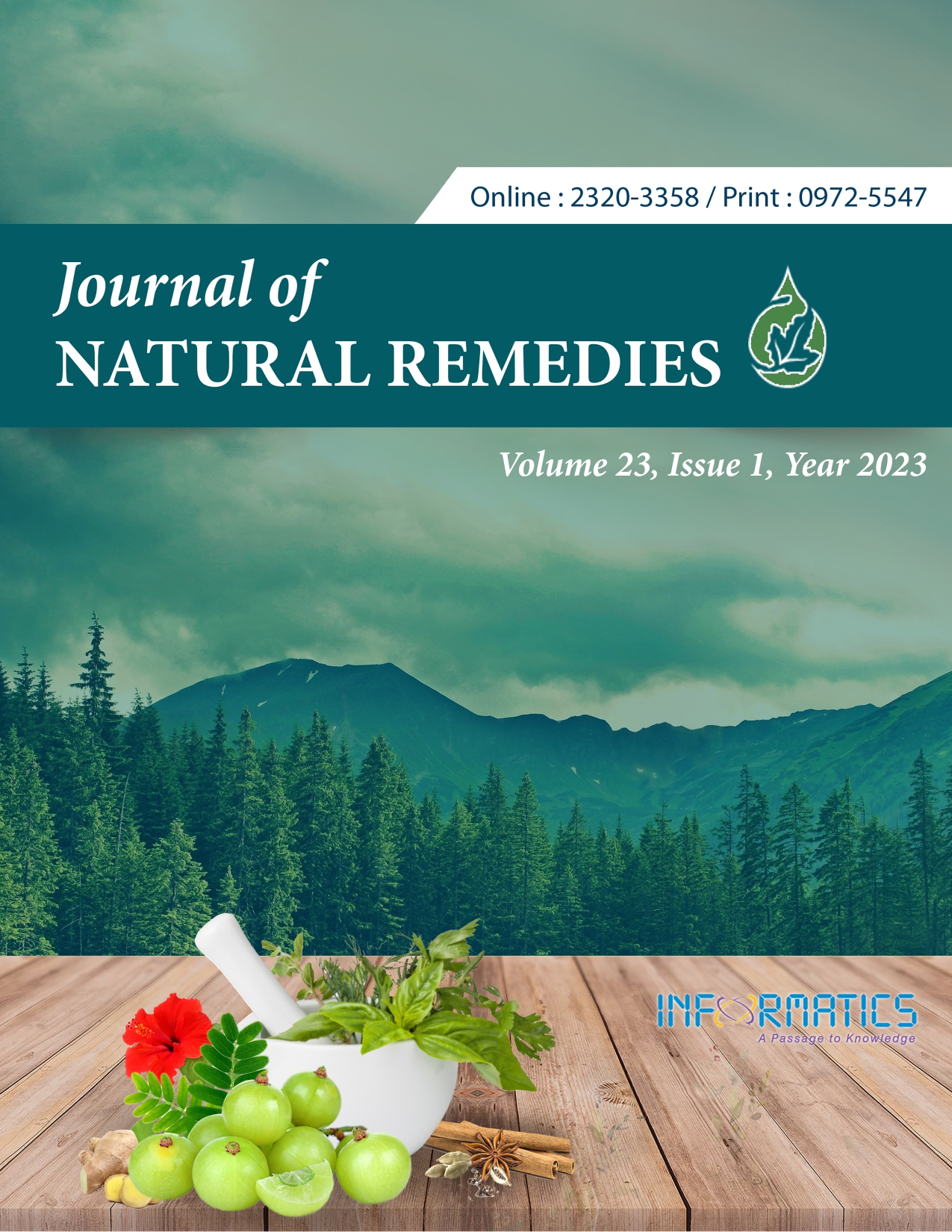Toxicity Status of Nano Powder of Stem Bark of Bauhinia Variegata Linn. on Experimental Animals
DOI:
https://doi.org/10.18311/jnr/2023/29566Keywords:
Bauhinia variegata Linn., Liver Toxicity, Medicinal Plant, SafetyAbstract
The assumption that medicinal plants are less toxic or cause fewer adverse effects due to their natural composition is debatable. Hence, this study was conducted to evaluate the safety and toxicity of Nano Kanchanara stem bark powder (NKSP) on liver function. The oral acute toxicity of NKSP was conducted in accordance with OECD Guidelines 423 and was carried out with six (6) female Wistar albino rats, divided into two groups of three rats each. Test rats were orally administered a single dose of 2000 mg/kg of NKSP and were observed for changes in behavior and mortality for the next 14 days, while the Control Group was given feed and water ad libitum. The data obtained from the oral acute toxicity study indicated that there were non-significant (P<1.000) decreases in body weight of rats in the treatment groups of NKSP at 2000 mg/kg. There were no elevations in specific liver function enzymes, whereas there were increases in serum SGOT, SGPT, and albumin levels. Plasma total proteins and globulin, total bilirubin and serum creatinine were within the normal range. Albeit, hydropic changes and steatosis in liver lesions at NKSP 2000 mg/kg. The study suggests that oral administration of NKSP is safer at dose levels less than 2000 mg/kg/day.
Downloads
Metrics
Downloads
Published
How to Cite
Issue
Section
License
Copyright (c) 2023 Prachi Vishwakarma, Prachi Vishwakarma

This work is licensed under a Creative Commons Attribution 4.0 International License.
Accepted 2022-09-08
Published 2023-03-23
References
Chopra A. Ayurvedic medicine and arthritis. Rheumatic Disease Clinics of North America. 2000 Feb 1;26(1):133-44. DOI: https://doi.org/10.1016/S0889-857X(05)70127-7
MR Y, MITTI JG, SHARMA VS. REVIEW ON CHURNA KALPANA.
Morganti P. Use and potential of nanotechnology in cosmetic dermatology. Clinical, cosmetic and investigational dermatology: CCID. 2010;3:5. DOI: https://doi.org/10.2147/CCID.S4506
Jain KK, Jain KK. The handbook of nanomedicine. NJ:: Humana Press; 2008 Feb 24. DOI: https://doi.org/10.1007/978-1-60327-319-0
Boholm M. The use and meaning of nano in American English: Towards a systematic description. Ampersand. 2016 Jan 1;3:163-73. DOI: https://doi.org/10.1016/j.amper.2016.10.001
Boholm M, Boholm Å. The many faces of nano in newspaper reporting. Journal of Nanoparticle Research. 2012 Feb;14(2):1-8. DOI: https://doi.org/10.1007/s11051-012-0722-y
Murthy CK, Lakshman SV, Buddhudu S. Indian Science Congress. Lacknow. 1985;72:4.
Baláž M. Environmental Mechanochemistry. Springer International Publishing; 2021. DOI: https://doi.org/10.1007/978-3-030-75224-8
Kumar P, Mahajan P, Kaur R, Gautam S. Nanotechnology and its challenges in the food sector: A review. Materials Today Chemistry. 2020 Sep 1;17:100332. DOI: https://doi.org/10.1016/j.mtchem.2020.100332
Dhand C, Dwivedi N, Loh XJ, Ying AN, Verma NK, Beuerman RW, Lakshminarayanan R, Ramakrishna S. Methods and strategies for the synthesis of diverse nanoparticles and their applications: a comprehensive overview. Rsc Advances. 2015;5(127):105003-37. DOI: https://doi.org/10.1039/C5RA19388E
Rajendran D, Thulasi A, Jash S, Selvaraju S, Rao SB. Synthesis and application of nano minerals in livestock industry. Animal nutrition and reproductive physiology (recent concepts). Satish Serial Publishing House, Delhi. 2013:517-30.
Pal G, Rai P, Pandey A. Green synthesis of nanoparticles: A greener approach for a cleaner future. InGreen synthesis, characterization and applications of nanoparticles 2019 Jan 1 (pp. 1-26). Elsevier. DOI: https://doi.org/10.1016/B978-0-08-102579-6.00001-0
Nijhara R, Balakrishnan K. Bringing nanomedicines to market: regulatory challenges, opportunities, and uncertainties. Nanomedicine: Nanotechnology, Biology and Medicine. 2006 Jun 1;2(2):127-36. DOI: https://doi.org/10.1016/j.nano.2006.04.005
Pham K, Li D, Guo S, Penzak S, Dong X. Development and in vivo evaluation of child-friendly lopinavir/ritonavir pediatric granules utilizing novel in situ self-assembly nanoparticles. Journal of Controlled Release. 2016 Mar 28;226:88-97. DOI: https://doi.org/10.1016/j.jconrel.2016.02.001
Dr Xiaorui Zhang. WHO guidelines on safety monitoring of herbal medicines in pharmacovigilance systems. Geneva. 2004. Annexure 3,4. Part 2. 2-5p
https://www.sciencedaily.com/terms/nanoparticle.htm
Osagie-Eweka SE, Orhue NE, Omogbai EK, Amaechina FO. Toxicity Status of Methanol Leaf Extract of Simarouba glauca on Rat Liver. https://www.researchgate.net/publication/346967243
Abid R, Mahmood R. Acute and sub-acute oral toxicity of ethanol extract of Cassia fistula fruit in male rats. Avicenna journal of phytomedicine. 2019 Mar;9(2):117.
Erhirhie EO, Ihekwereme CP, Ilodigwe EE. Advances in acute toxicity testing: strengths, weaknesses and regulatory acceptance. Interdisciplinary toxicology. 2018 May 1;11(1):5-12. DOI: https://doi.org/10.2478/intox-2018-0001

 Prachi Vishwakarma
Prachi Vishwakarma









 0.35
0.35 24
24 0.161
0.161